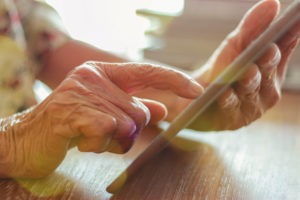Going places
When Harriet Gerson first moved into independent living, she wasn’t ready to give up the keys. The then 94-year-old had places to go and people to see. And, she could still get around, she says.
Gerson still gets around. Only now, she doesn’t get behind the wheel.
Gerson learned the shuttle schedule at The Palace at Coral Gables, and her granddaughter helped install ride-hailing apps on her smartphone. Now she has the freedom to go to the doctor and visit friends whenever she wants—regardless of the schedule.
“When I moved to The Palace, I had an automobile, and I drove,” Gerson, 96, says to I Advance Senior Care. “But then I decided to sell my automobile because I could use Uber and Lyft.”
Gerson is an independent social butterfly and, like a growing number of seniors, uses on-demand ride-hailing services to get where she wants to go, when she wants to go.
Many of The Palace’s 250 independent and assisted living residents drive or have a friend in the community who does. Otherwise, that’s when the community’s shuttle van and ride-hailing companies come into play, says Anthony Costas, director of customer service.
“We definitely want residents to feel as independent as possible,” he says. “One of the advantages of using companies like Lyft, Uber and GoGoGrandparent is that residents don’t feel like they are stuck. They don’t have to rely on others or their schedule, so that gives them the liberty to do what they want and remain active.”
Ride-hailing may be trending at The Palace, but a May 2016 report from the Pew Research Center suggests the community is still an early adopter. In its report, “Shared, Collaborative and On Demand: The New Digital Economy,” Pew found just 15 percent of American adults have used ride-hailing apps. Of them, only 4 percent were age 65 or older. However, more than 51 percent of Americans are familiar with ride-hailing services even though they haven’t used them, according to the Pew report.
Leading indicators suggest ride-hailing is picking up speed, and other startups are entering the arena with an eye on the fastest-growing demographic: seniors. Pew survey respondents were asked to choose what ride-hailing services do well from a list of options, and 73 percent said it’s a “good option for older adults with limited mobility,” the third most popular response.
Catching a ride
Ride-hailing companies work through smartphone applications to connect riders with drivers, who transport them in their personal cars. Both parties see each other’s profiles, which includes star ratings, photos, first names, temporary contact information and real-time location. Riders can also see the vehicle make, model, color and license plate number.
Since the companies launched, only people with smartphones who were comfortable and capable of using the technology could take advantage of ride-hailing. Then, in 2016, Uber and Lyft launched desktop web-based enterprise platforms that allow organizations to request a ride on another’s behalf, respectively called Uber Central and Lyft Concierge. Now riders no longer need to use an app or own a smartphone, an important consideration with seniors.
The digital barrier is so significant that Justin Boogaard formed a company on it. GoGoGrandparent is a third-party go-between that allows seniors to call a toll-free number to catch a ride with Uber and Lyft. GoGoGrandparent staff help request and monitor rides and serve as an intermediary. The company works directly with senior consumer users to help them enjoy the benefits of on-demand transportation without having to worry about the technology.
“It wasn’t supposed to be a business,” Boogaard says. “I made it for my grandma because she was uncomfortable driving at night and wouldn’t call me for rides.”
He says word quickly spread at his grandma’s bridge club, revealing a need within the existing ride-hailing market. A May 2017 Pew report on tech adoption among older adults found 80 percent of seniors age 65 and up own a cellphone and, of them, 42 percent own a smartphone. Ownership declines with age, so only 17 percent of seniors age 80 and older have a smartphone.
Hopping on board
Ride-hailing is something Andy Smith, director of innovation and strategy at Brookdale Senior Living, has wanted for years in long-term care. Brookdale and Lyft have partnered to make the service available at more than 30 Brookdale communities nationwide, most which are independent living.
“Ride-hailing is one of the first times that we’ve been able to provide a safe, consistent, convenient and relatively inexpensive transportation option for seniors in a way that meets them where they are at technologically,” he says. “Not all seniors are comfortable with a smartphone or putting their credit card into an app. What Lyft has done with their Concierge program has really opened up a whole new world of opportunities to our residents, and that’s definitely worth the buzz.”
Smith says they weren’t sure what to expect once they started rolling out Lyft as part of a pilot program in fall 2016. Like many senior living providers, Brookdale operates a fleet of town cars and buses. They predicted fleet use would decrease because residents would opt for the on-demand convenience of Lyft.
More than 50 percent of residents at Brookdale Redwood City in California tried Lyft, more than 30 percent repeatedly used the service. Smith says he’s delighted to report those numbers have held steady as Lyft has expanded to more communities. In fact, repeat riders have slightly increased. Brookdale’s fleet is being used more in addition to Lyft, meaning more residents than ever before are getting active and involved.
“What we found is that once we get something up and running, a few residents take a ride and they see the value, it truly does spread like wildfire,” says Dan Trigub, head of West Cost healthcare partnerships at Lyft.
Wednesday is the most popular ride day at 23.5 percent, and weekends are noticeably slower. Residents are traveling 10 or more miles away from the community, a distance they might not be able to go by facility transportation. The numbers, Smith says, are signs that Lyft is a good supplemental service to what Brookdale provides.
Under the hood
Uber Central and Lyft Concierge expand on the companies’ core offerings. The enterprise platforms use the existing driver network as the consumer platforms and the same dynamic pricing model. That means seniors can wait less and pay less to go somewhere than they would with a traditional taxi.
The biggest differences are for senior living providers. Residents can call the front desk and ask for a ride. The front desk uses the web portal to request a ride for residents from a central platform. If residents have a cellphone, they can opt for text message status updates, such as when a car is on its way, a feature that’s offered for consumer users.
Like consumer users, seniors don’t have to worry about or fumble with cash. Ride-hailing companies instead issue monthly invoices to senior living providers, who can choose to pass the cost on to residents like any ancillary service, subsidize or absorb the cost. Trigub says the fact that seniors don’t have to give their credit card information is an extra security measure for a financially vulnerable population.
Uber Central and Lyft Concierge allows providers to track the car’s location in real time and send notifications about the ride, features that offer peace of mind for providers and residents’ loved ones. It’s also a comfort for residents. Costas says some residents, often women, can be anxious about taking a taxi.
These are all indications for a real need to help seniors get around, says Jay Holley, product strategy at Uber.
“I think there are a lot of people who are recognizing there hasn’t really been a great solution to empower people who maybe shouldn’t be driving themselves, to give them the freedom and mobility that they want and deserve,” he says. “We’re able to fill a need we think there is very substantial demand in and desire for. It’s adding another gear to the system.”
Gerson praises The Palace’s transportation and uses it regularly. The facility has a bus that runs on a schedule with multiple pickups and drop-offs each day. If she needs to go someplace else, she calls for a ride. Gerson estimates she uses ride-hailing services once or twice a week.
“It’s very convenient,” Gerson says. “Once I get in the car, they take me to my destination, they open the door, hand me my walker, and I go.”
Picking up speed
Holley says there’s a real cost to providers to operate their fleets. It’s a fact not to be ignored, but he says fleets can also impose artificial constraints with very real implications on residents’ quality of life.
“When I get hungry or I want to shop for a new pair of shoes, I have the luxury and convenience of being able to decide to go to the grocery store or mall,” Holley says. “When you have to wait until Tuesday at 2 p.m. to have that experience, you lose a little bit of that independence and mobility. One of the exciting and powerful things about ride-hailing is it gives that decision-making power back to the person who maybe had the keys taken away from them.”
Smith says the ride-hailing is a supplemental service in addition to a fleet of buses and town cars that may offer operate with restricted hours, within a certain radius and require advanced scheduling. He says Brookdale is pleased with Lyft and is making ride-hailing available to any community that wants to use it. The company is evaluating how to better integrate Lyft into its broader transportation offering. But Smith is also quick to note Lyft won’t replace the existing fleet. At least, not for the foreseeable future.
Ride-hailing services aren’t available in all communities and are primarily for curb-to-curb transportation. Uber and Lyft don’t have a large fleet of wheelchair-accessible vehicles or nonemergency transportation for non-ambulatory seniors with additional health needs. Both Trigub and Holley acknowledge their services aren’t a perfect fit for everyone, but they are trying to expand and improve ride-hailing to give more seniors a ride.
Uber offers uberASSIST, an additional service level feature where drivers can offer door-to-door transportation. Drivers complete training on how best to fold a walker or wheelchair and how to help escort a rider into the car.
Trigub says Lyft drivers will help with mobility aids and is trying to expand vehicle offerings, too. The company has some wheelchair-accessible vehicles and wants to add more to its network. And, Trigub notes, there’s no additional cost for additional passengers. So, ride-hailing could help residents in assisted living or memory care go to the doctor’s office with a caregiver without having to arrange and wait for a shuttle, which would free the shuttle and driver for other uses.
The companies are forging new paths, and the ride-hailing industry could dramatically change—it’s still in its infancy, after all. But at the end of the day, it’s a means to give seniors control, reduce isolation and improve their quality of life. Ride-hailing gives seniors the freedom to go grab a cup of coffee with a friend without feeling like they’re bothering their kids or putting themselves—and others on the road—at risk.
“Being able to give them the power to still go out of the house without having to give them the burden of driving a 2,000-pound vehicle is one of the most magical things about this experience,” Holley says. “There are pretty important mental health implications. It’s being able to get that that life back, so to speak.”

Nicole was Senior Editor at I Advance Senior Care and Long Term Living Magazine 2015-2017. She has a Journalism degree from Kent State University and is finalizing a master’s degree in Information Architecture and Management. She has extensive studies in the digital user experience and in branding online media. She has worked as an editor and writer for various B2B publications, including Business Finance.
Related Articles
Topics: Articles , Executive Leadership , Technology & IT











